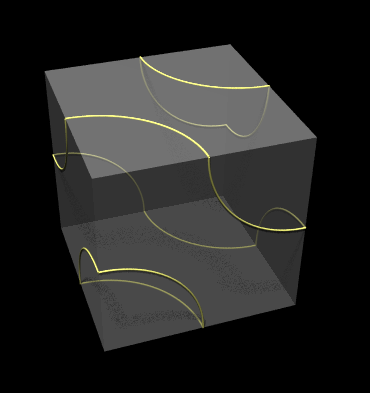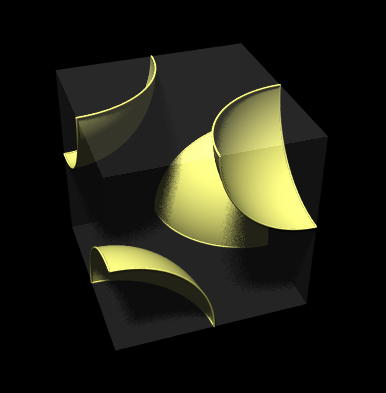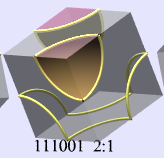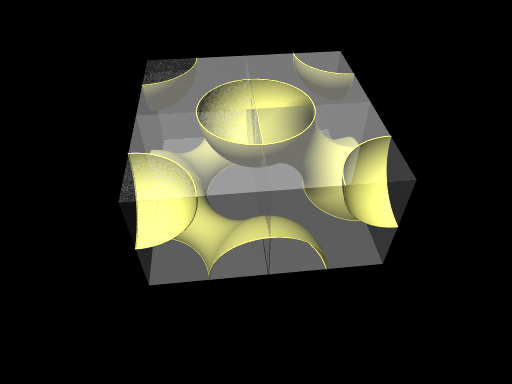
|

|

|

|

|

|

|

|

CTK Exchange
Lars

guest
|
Jul-19-07, 09:33 PM (EST) |
|
|
"smooth surfaces bounded by circle-sections in a cube"
| |
Hello,
I've been thinking about 3D truchet tilings recently, as shown on pages like this and this.The above, like most of the "3D truchet tiling" I have found on the web, uses tubes: each cubic tile contains three tubes, and each tube (rendered as a quarter-torus or something similar) connects the centers of two adjacent cube faces.
(Or else it has just been a 3D rendering of a 2D truchet tiling.) My question has to do with another 3D analog of truchet tiling. The 3D analog I've been thinking of uses surfaces instead of pipes.
It'starts by making each face of the cubic tile a copy of the 2D truchet tile, i.e. it has two quarter-circles in the plane of the face:  . .
Then we connect the quarter-circles in the cube faces to each other using surfaces.
For example, using a minimal surface. Sketching an example by hand, the minimal surface stretched between these curves looks pretty interesting. But this is where I get stuck: I don't have near the math knowledge to model such a surface. I've read some things about minimal surfaces, but there are many different kinds, and I don't know to apply them to this situation. The good news is, I don't think there are very many different possibilities for this family of 3D tiles, when you eliminate duplicates under reflection and rotation. (I've counted 5, and there may be a few more.) The trivial case has four sphere-octants, one in each of four corners of the cube: 
That's the only case where I know how to model all the surfaces. Actually, I'm not sure that minimal surfaces are the best answer. In order for tiling to work, the surfaces need to follow two constraints:
(1) They need to intersect the cube faces (only) along the quarter-circles.
(2) They need to intersect each cube faces at a right angle to the face, so that they fit'smoothly with the surfaces in neighboring cubes.
A minimal surface may not always meet constraint (2). In fact I suspect in the trivial case in image 2, a minimal surface (instead of a sphere-octant) wouldn't intersect the faces at right angles. On the other hand, constraint (2) is somewhat arbitrary. The surfaces don't necessarily have to join smoothly. I just think it would just look nicer. My goal was to write an OpenGL animation, for viewing pleasure (e.g. as a screensaver). So ultimately Iíll need to make it fast enough to animate. Any ideas for how to mathematically model smooth surfaces that would join the curves? Some sort of quadric surface? Thanks,
Lars
|
|
|
Alert | IP |
Printer-friendly page |
Reply |
Reply With Quote | Top |
|
|
Lars

guest
|
Jul-20-07, 02:38 PM (EST) |
|
|
1. "RE: smooth surfaces bounded by circle-sections in a cube"
In response to message #0
| |
I've gotten a little farther on this. I've enumerated the 64 possible cubes graphically, and have been classifying them. So far there are 7 unique variants, are there may be one or two more. I looked for a relatively simple surface to use as a starting point to figure out how to model the surfaces. Hopefully if I can succeed with this one, it will be a step toward solving the harder ones. One simple example is: 
As you can see, the Truchet curves delimit two sphere-sections and one "other" surface which lies along the "floor". (The vertex nearest the viewer is <1,1,0>; the opposite vertex is <0,0,1>.) In the enumeration of the 64 possibilities, this is cube 111001, classified as 2:1b (2 spherical sections, 1 other surface, unique variant b). The cube is the unit cube (size s = 1). Here are the equations I'm able to come up with for the surface.
(A) The surface intersects the cube faces along quarter-circles as shown. This is expressed as:
When z=0, x^2 + y^2 = r^2.
When x=0, y^2 + z^2 = r^2. (So far, x^2 + y^2 + z^2 = r^2, but not for long.)
When y=0, x^2 + (z-s)^2 = r^2 or (x-s)^2 + z^2 = r^2. (The latter if x>z; the former otherwise.)
When x=1, y^2 + (z-s)^2 = r^2.
When z=1, (x-s)^2 + y^2 = r^2.
Can we unify that all into one equation? We want the surface to be smooth, so that means there is a first derivative and it is continuous everywhere in the domain (0 to 1 for each axis). (I don't think the 2nd derivative needs to be continuous... what do you think?) So I suppose what that means is I have to restrict my equations to those that use functions that are differentiable and whose first derivative is continuous.
Differentiable with respect to what? I'm not sure. In the equation for a sphere, x^2 + y^2 + z^2 = r^2, I guess the functions for x, y, and z each need to be (and are) differentiable with respect to the other two variables...? Also, we would like the surface to intersect the faces at right angles; that's expressed as:
When z=0 or 1, dy/dz = dx/dz = 0.
When x=0 or 1, dy/dx = dz/dx = 0.
When y=0, dx/dy = dz/dy = 0. The shape of the surface is saddle-like in the middle, so maybe I need something like a hyperbolic paraboloid. That doesn't work at the faces though. Any ideas? Maybe I could use whatever they use for "blobs" in raytracing? Thanks,
Lars |
|
|
Alert | IP |
Printer-friendly page |
Reply |
Reply With Quote | Top |
|
|
 |
alexb
Charter Member
2057 posts |
Jul-20-07, 06:26 PM (EST) |
    |
2. "RE: smooth surfaces bounded by circle-sections in a cube"
In response to message #1
| |
>Differentiable with respect to what? I'm not sure. In the
>equation for a sphere, x^2 + y^2 + z^2 = r^2, I guess the
>functions for x, y, and z each need to be (and are)
>differentiable with respect to the other two variables...? You should consider functions f(x, y, z) of three variables and their partial derivatives. For example, the partial derivative δf/δx with respect to x is a common derivative d/dx computed under the assumption that the other two variables are constant. The result, generally speaking, is still a function of three variables. E.g, if f(x, y, z) = x2y + sin(xz), then δf/δx = 2xy + z∑cos(xz). Vector (δf/δx, δf/δy, δf/δz) is normal to the surface f(x, y, z) = const. It is also called the gradient of f. You, probably, want this vector to be a continuous function of vector (x, y, z). It is not difficult to construct a surface through two arcs. I am not clear yet how to satisfy your differentiability requirement. |
|
|
Alert | IP |
Printer-friendly page |
Reply |
Reply With Quote | Top |
|
|
|
alexb
Charter Member
2057 posts |
Jul-20-07, 06:34 PM (EST) |
    |
4. "RE: smooth surfaces bounded by circle-sections in a cube"
In response to message #0
| |
>(1) They need to intersect the cube faces (only) along the
>quarter-circles.
>(2) They need to intersect each cube faces at a right angle
>to the face, so that they fit'smoothly with the surfaces in
>neighboring cubes.
This is a sufficient but not a necessary condition.>On the other hand, constraint (2) is somewhat arbitrary. They may join smoothly even if not orthogonal to the face of a square. But if you allow that, you'll have to exercise more care while tiling.
|
|
|
Alert | IP |
Printer-friendly page |
Reply |
Reply With Quote | Top |
|
|
 |
Lars

guest
|
Jul-23-07, 06:50 AM (EST) |
|
|
5. "RE: smooth surfaces bounded by circle-sections in a cube"
In response to message #4
| |
Hi Alexb,
Thanks for your reply.
>>(1) They need to intersect the cube faces (only) along the
>>quarter-circles.
>>(2) They need to intersect each cube faces at a right angle
>>to the face, so that they fit'smoothly with the surfaces in
>>neighboring cubes.
>This is a sufficient but not a necessary condition.
>
>>On the other hand, constraint (2) is somewhat arbitrary.
>
>They may join smoothly even if not orthogonal to the face of
>a square. But if you allow that, you'll have to exercise
>more care while tiling.
Right... I was assuming, and maybe this needs to be made explicit, that any tile can be placed next to any other tile, with no constraints on the orientation of either. So my goal is to design tiles such that you don't have to exercise care while tiling. Having all the surfaces intersect the faces at a right angle seemed the easiest way to do that.
So far, I've gotten some good results with "blob" objects in POV-ray. E.g. 
They seem to be smooth, intersect the faces along the desired arcs, and do so at a right angle. The documentation says that the blob is an isosurface of the function f(x,y,z) = strength*(1 - (distance / r)^2)^2 - threshold. So hopefully I can use that to compute surface polygons in OpenGL. I have not yet tried this approach with the other cases (more complex surfaces, involving up to 12 arcs). > It is not difficult to construct a surface through two arcs. Could you elaborate on how to do that?
Can it work for four arcs, or more? (The simplest case, shown in the image above, involves four arcs.) Regards,
Lars |
|
|
Alert | IP |
Printer-friendly page |
Reply |
Reply With Quote | Top |
|
|
|
 |
alexb
Charter Member
2057 posts |
Jul-23-07, 09:22 AM (EST) |
    |
7. "RE: smooth surfaces bounded by circle-sections in a cube"
In response to message #5
| |
>> It is not difficult to construct a surface through two arcs.
>
>Could you elaborate on how to do that? Parametrize your quarter circles. E.g, if cube's edge is taken to be 2, x = cos(t), y = sin(t), z = 0, and
x = 0, y = sin(t), z = 2 - cos(t), for two arcs on z = 0 and x = 0 faces. Let these be points P(t) and Q(t). Now take any continuous function g(s) whatsoever defined on and with values in [0, 1] You can consider a parametrized surface f(s, t) = P(t)g(s) + Q(t)(1 - g(s)). Then f(0, t) = Q(t) and f(1, t) = P(t). P.S. To satisfy you second condition is of course more difficult. |
|
|
Alert | IP |
Printer-friendly page |
Reply |
Reply With Quote | Top |
|
|
|
 |
Lars

guest
|
Jul-24-07, 06:41 AM (EST) |
|
|
8. "RE: smooth surfaces bounded by circle-sections in a cube"
In response to message #7
| |
>>> It is not difficult to construct a surface through two arcs.
>>
>>Could you elaborate on how to do that?
>
>Parametrize your quarter circles. E.g, if cube's edge is
>taken to be 2,
...Thanks for this explanation. Now that you point it out, it does seem obvious that you could construct a surface through two arcs. I'm not sure though that I know how to extend that to construct a surface through six, nine, or 12 arcs. I did find the Surface Evolver, which should enable me to compute minimal surfaces that intersect the arcs. Very nice! Whether I can get it to satisfy the 2nd constraint (smooth interfaces between surfaces in adjacent cubes) remains to be seen. Thanks again,
Lars
|
|
|
Alert | IP |
Printer-friendly page |
Reply |
Reply With Quote | Top |
|
|
|
 |
Lars

guest
|
Jul-23-07, 06:50 AM (EST) |
|
|
6. "RE: smooth surfaces bounded by circle-sections in a cube"
In response to message #4
| |
Oops, I said that the simplest surface (besides the sphere octants) involved four arcs. I should have said, six arcs.
Lars |
|
|
Alert | IP |
Printer-friendly page |
Reply |
Reply With Quote | Top |
|
|
|

You may be curious to have a look at the old CTK Exchange archive.
Please do not post there.


![]()
Copyright © 1996-2018 Alexander Bogomolny
|
|